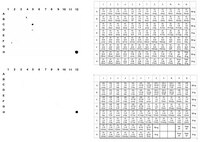Wnt/β-catenin dependent cell proliferation underlies segmented lateral line morphogenesis.
Aman, Andy, et al.
Dev. Biol., 349: 470-82 (2011)
349
2010
Zobrazit abstrakt
Morphogenesis is a fascinating but complex and incompletely understood developmental process. The sensory lateral line system consists of only a few hundred cells and is experimentally accessible making it an excellent model system to interrogate the cellular and molecular mechanisms underlying segmental morphogenesis. The posterior lateral line primordium periodically deposits prosensory organs as it migrates to the tail tip. We demonstrate that periodic proneuromast deposition is governed by a fundamentally different developmental mechanism than the classical models of developmental periodicity represented by vertebrate somitogenesis and early Drosophila development. Our analysis demonstrates that proneuromast deposition is driven by periodic lengthening of the primordium and a stable Wnt/β-catenin activation domain in the leading region of the primordium. The periodic lengthening of the primordium is controlled by Wnt/β-catenin/Fgf-dependent proliferation. Once proneuromasts are displaced into the trailing Wnt/β-catenin-free zone they are deposited. We have previously shown that Wnt/β-catenin signaling induces Fgf signaling and that interactions between these two pathways regulate primordium migration and prosensory organ formation. Therefore, by coordinating migration, prosensory organ formation and proliferation, localized activation of Wnt/β-catenin signaling in the leading zone of the primordium plays a crucial role in orchestrating lateral line morphogenesis. | 20974120
 |
Regulation of chromatin structure by histone H3S10 phosphorylation.
Johansen, Kristen M and Johansen, Jørgen
Chromosome Res., 14: 393-404 (2006)
2005
Zobrazit abstrakt
The epigenetic phospho-serine 10 modification of histone H3 has been a puzzle due to its association with two apparently opposed chromatin states. It is found at elevated levels on the highly condensed, transcriptionally inactive mitotic chromosomes yet is also correlated with the more extended chromatin configuration of active genes, euchromatic interband regions, and activated heat shock puffs of Drosophila polytene chromosomes. In addition, phosphorylation of histone H3S10 is up-regulated on the hypertranscribed male X chromosome. Here we review the cellular effects of histone H3S10 phosphorylation and discuss a model for its involvement in regulating chromatin organization and heterochromatization that would be applicable to both interphase and mitotic chromosomes. | 16821135
 |











